Delidding The AMD Ryzen 5 2400G APU: How To Guide and Results
by Gavin Bonshor on May 10, 2018 8:00 AM EST- Posted in
- CPUs
- Guides
- APUs
- Ryzen
- Ryzen 3 2200G
- Ryzen 5 2400G
- Delidding
- Delid
Delidding The Ryzen 5 2400G Results and Conclusion
There has been a lot of hype since the launch of the Ryzen 2000 series APUs and in our Ryzen 5 2400G review, it’s noted that in multiple scenarios they outperform the competing Intel counterparts second to none in pixel rendering tests such as gaming, mainly thanks in no small part to the integrated iGPU featuring Vega cores. The aim of today’s testing with our best Ryzen 2000 series APU from a purely CPU frequency-based standpoint was to ascertain whether delidding makes a noticeable improvement to thermal performance, as well as determining if any extra headroom in CPU core frequency is made available.
As per our regular motherboard testing methodology when we find the max stable overclock, testing was done following the same procedure. Following on from the testing done in our Ryzen 2000 series APU overclocking guide, the aim in this was to continue with simple overclocking to push the core frequency.
To start, here are our initial overclocking results with the retail chip as sold:
After delidding the chip, replacing the paste with a liquid metal TIM, we achieved the following results:
Not only are the thermal properties improved from delidding and having the IHS slavered up with Thermal Grizzly Conductonaut liquid metal compound but operating at the previously unstable frequency of 4.2 GHz was made possible after delidding. Even at 4.2 GHz with the 2400G delidded, the temperatures hit the same levels as 4.0 GHz non delidded which is quite impressive. Even more monumental was the system managed to boot into Windows 10 at a clock speed of 4.3 GHz, although the system wouldn’t just hang when OCCT was fired up, it would crash completely meaning that even with a good AIO CPU cooler and being de-lidded, no more than 4.2 GHz was stable with this particular chip.
The best way to represent some of this data is in graphs. First up is the main one, temperature:
This is a clear representation showing the decrease in CPU temperature after the delidding process. The higher the frequency, the bigger the overall difference!
For power consumption, there was almost zero difference. This is to be expected: the chip will still consume the same amount of power with a standard temperature window. The cooler still has to remove the heat energy, however it is now being transferred better to the cooler through the new TIM.
The interesting result here is POV-Ray. We use POV-Ray in our overclock testing as it is usually very good if there are cache and memory errors associated with the high frequency. However here we see that beyond about 3.8 GHz, the retail processor has trouble getting more performance at a higher frequency, likely due to the CPU reaching thermal limits and the frequency mechanisms having to compensate. The end result is 'sustained' performance at higher frequencies. Due to the delid process, this was not an issue through to 4.2 GHz. Having the extra thermal headroom ultimately gave both more frequency and better sustained performance.
Is Delidding the Ryzen 2400G Worth it? Risk Versus Reward
As previously stated, the primary use where I could see delidding a Ryzen 2000 series APU viably applicable would be in a situation where cooling restrictions are in place such as a small form factor system or a HTPC. The benefits of the reduction in temperature would allow for a more svelte and slim line cooler to be used without pushing towards the maximum operating temperature.
Another less but pertinent use would be for performance users wanting faster clock speeds, although at a cost of voiding the warranty, potentially damaging and killing the chip itself during the process, and the added cost of the tools, it could be a price too much in retrospective which could be spent on a better CPU to begin with. Some vendors in the EU such as Caseking are actually selling pre-delidded Ryzen 3 2200G and Ryzen 5 2400G chips with their own warranties at an additional cost, which is often a better idea than manually performing the process and shelling out for the extra tools. That’s all good, providing this option is available to the user, although so far, I have yet to be able to find a large vendor offering this service in the US.


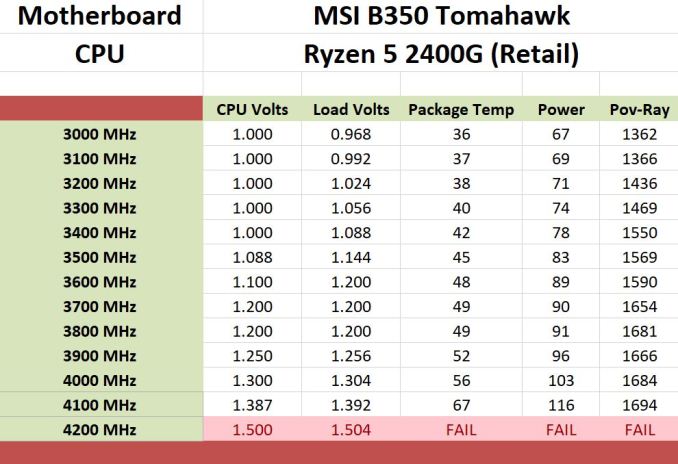
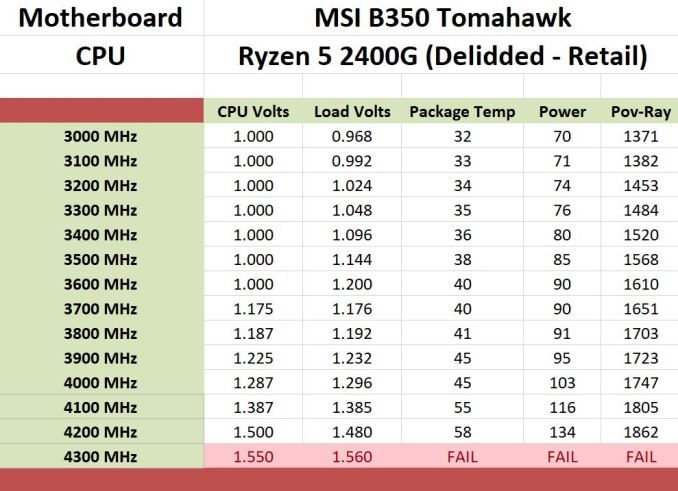
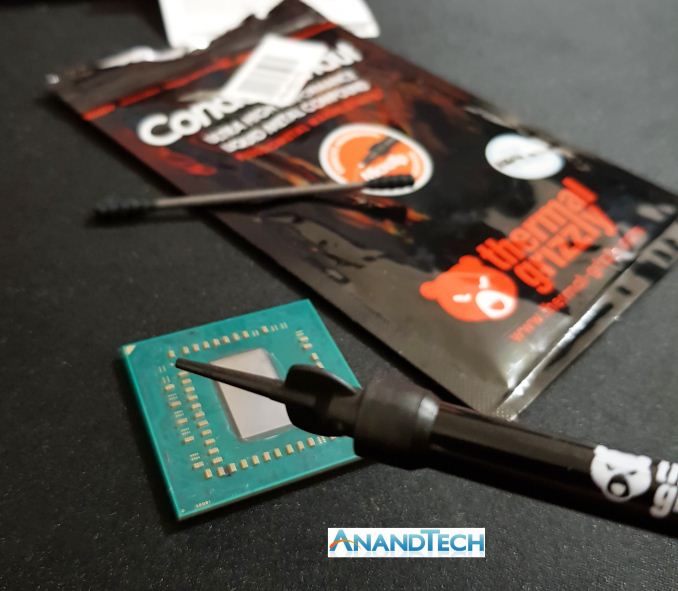
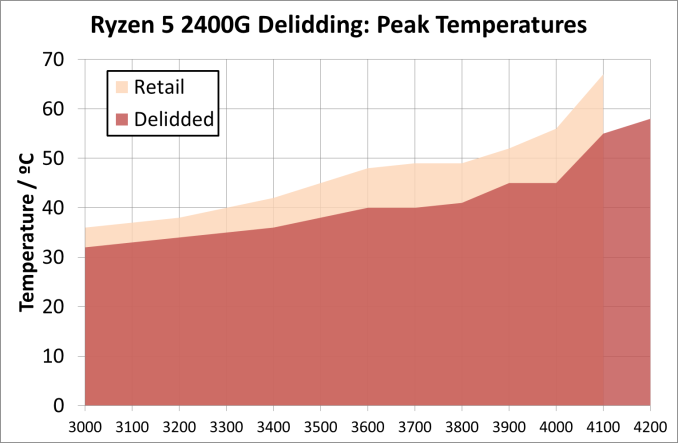

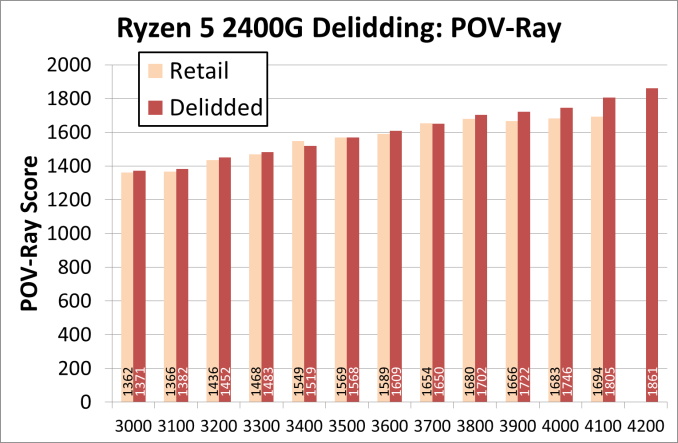








73 Comments
View All Comments
AntonErtl - Sunday, May 20, 2018 - link
About relidding vs. naked die. Looking at some other delidding articles, the reasons for relidding are related to the LGA sockets: the chip needs to be pressed on the springs for electrical contact (not just for good cooler contact; the mounting bracket of the LGA sockets is designed to press onto the heat spreader, and one has to find a replacement for that if the heat spreader is missing. Also, the mounting bracket is in the way of the usual coolers if you go for direct-die mounting, so you need to remove it, and replace it with something else.Antway, none of these problems is there for PGA sockets. I have recently looked at an AM4 CPU in its socket, and at least the cooler we use (Thermalright AXP-200R ROG) would not collide with the socket if mounted a little lower, and I guess this will be true for most other coolers. The only issue is that the mounting system would have to be adapted to mount the cooler that bit lower. The Thermalright AXP-200R uses a bracket that presses the cooler on the CPU; I would put something of the appropriate thickness between the bracket and the cooler.
Concerning the fear of breaking the die, I know of only one case of a broken die from the Athlon/Pentium III days: A friend of mine built his own water cooler, and when he was finished, he mounted it with a screwing mechanism. In the end, he wanted to give a screw another turn for good measure, but that was too much, and the Athlon broke. A case where the die survived was a cooler that was mounted in the wrong way, and sat one-sided on a Celeron. This was noticed because the Celeron was very slow, thanks to thermal throttling.
Concerning whether it pays off: It seems obvious to me that one would do that with a Ryzen G not as a particularly cost-effective way to get more performance, but because one wants to play around with delidding and other exotic cooling techniques. And in that context, a Ryzen G is a not-too-expensive playground.
ballsystemlord - Wednesday, May 23, 2018 - link
Here a a bunch of corrections to your spellllling grammar."and the Delid Die Mate 2 AMD Kit. This to our knowledge is"
An introductory clause needs comas.
"and the Delid Die Mate 2 AMD Kit. This, to our knowledge, is"
"Making sure the chip is placed into the tool the correct way allows
the tool can do its job properly; putting a case fan the wrong way"
Wrong word. Substitute "to" in place of "can".
"Making sure the chip is placed into the tool the correct way allows
the tool to do its job properly; putting a case fan the wrong way"
"between the die and IHS. One wrong jerk could or misplacement could get"
Double "could".
"between the die and IHS. One wrong jerk or misplacement could get"
Thanks!
Bill.Amd - Saturday, September 22, 2018 - link
Please go Extreme.What is the point of adding liquid metal on the cpu core when deliding you can remove a hole layer og TIM?
Over the past years I have delided many K8 and K10 AMDs and adddind a copper thermaltake volcano just on the cpu core the results were impressive. Great overclocking ability and at lowest fan speeds.
You have a AIO watercooler and removed the amd retaining base. The AIO waterblock has a copper base. I would like to see it attached directly on the cpu core.
And I would like to see something I never had the chance to test.. Water flowing directly around the cpu core! I had never the chance to make such a container but the results would be interesting for sure..
Please go EXTREME!